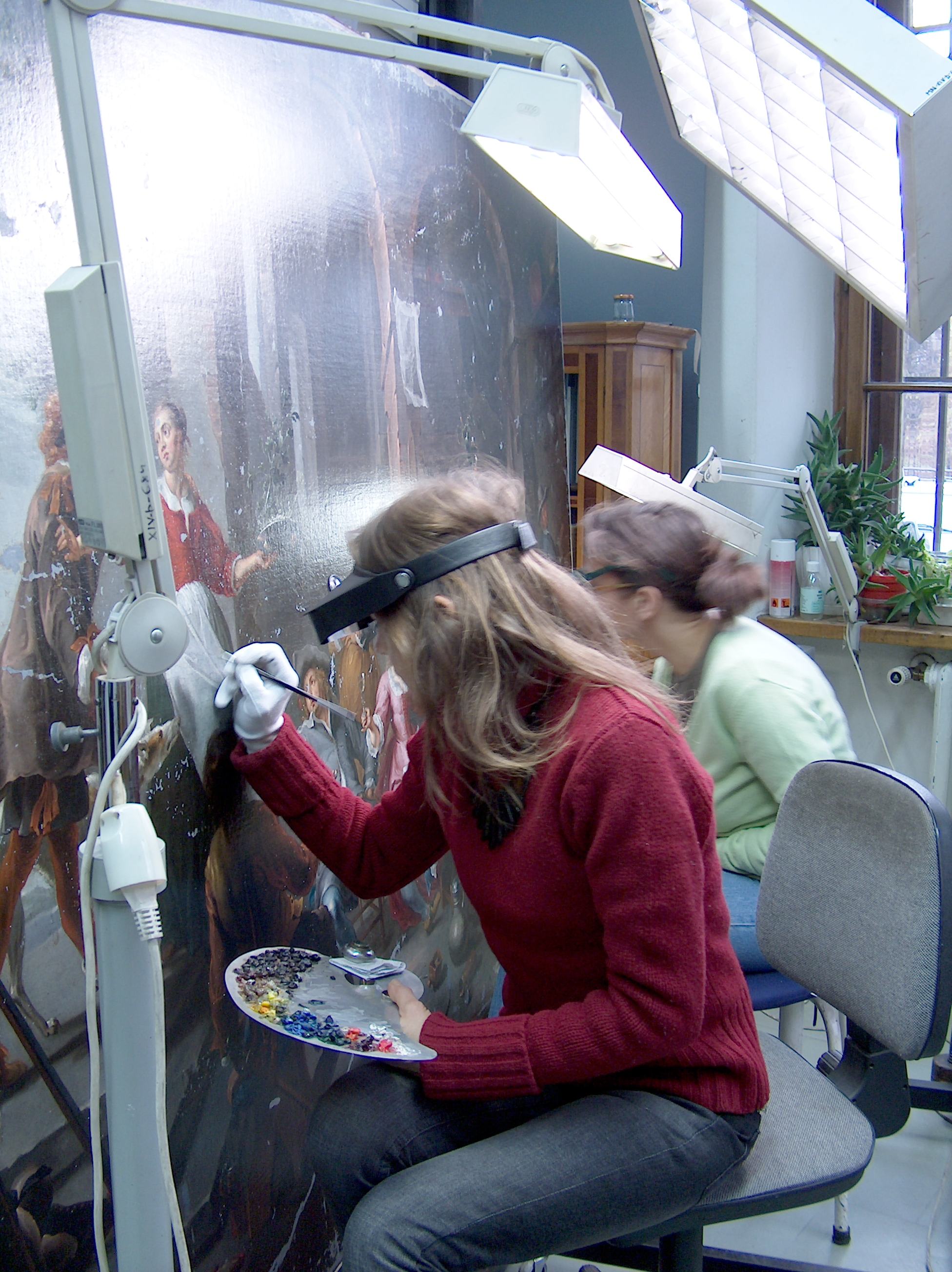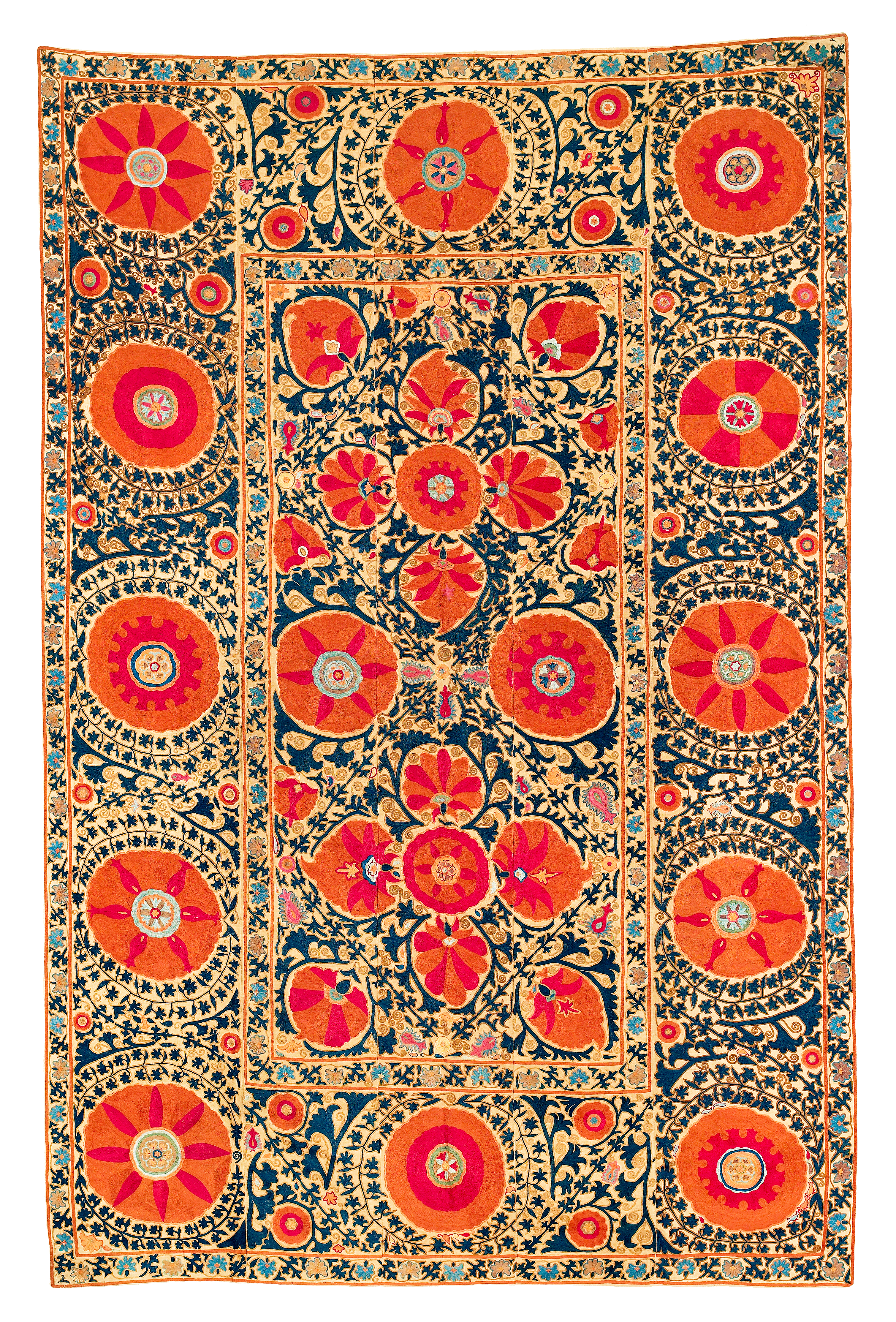|
Alvina Shpady
Alvina Andreevna Shpady (January 31, 1935 – June 22, 2019; ) was an artist and art restorer in Uzbekistan. As a longtime restorer at the Nukus Museum of Art, she worked to preserve the museum's holdings as well as to promote traditional Karakalpak textile techniques. Biography Alvina Shpady was born in 1935 in Baýramaly, the capital of Turkmenistan's Mary Region. Her family were Volga Germans who had been resettled further east in the Soviet Union. Shpady studied at the Shota Rustaveli Turkmen State Art School in the Turkmen capital of Ashgabat, graduating in 1957. She then returned for a few years to Baýramaly, where she taught art to secondary school students and worked as a cartographer for geologists. Then, in 1960, she moved the Uzbek Soviet Socialist Republic, settling in Nukus, where she began working at the regional branch of the Academy of Sciences of Uzbekistan. There, she met and began a long working partnership with the artist and collector Igor Savitsky. In 19 ... [...More Info...] [...Related Items...] OR: [Wikipedia] [Google] [Baidu] |
Conservator-restorer
A conservator-restorer is a professional responsible for the preservation of artistic and cultural artifacts, also known as cultural heritage. Conservators possess the expertise to preserve cultural heritage in a way that retains the integrity of the object, building or site, including its historical significance, context and aesthetic or visual aspects.Defining the Conservator: Essential Competencies. (2003). Retrieved from http://www.conservation-us.org/docs/default-source/governance/defining-the-conservator-essential-competencies.pdf. This kind of preservation is done by analyzing and assessing the condition of cultural property, understanding processes and evidence of deterioration, planning collections care or site management strategies that prevent damage, carrying out conservation treatments, and conducting research.Careers in Conservation. (2014). Retrieved from http://www.conservation-us.org/publications-resources/careers-in-conservation/become-a-conservator#.VPPIxMaLTwN ... [...More Info...] [...Related Items...] OR: [Wikipedia] [Google] [Baidu] |
Uzbekistan State Institute Of Arts And Culture
Uzbekistan State Institute of Arts and Culture (UzSIAC), based on the original Ostrovsky Institute and created by merging the Uzbekistan Institute of Arts and Tashkent State Institute of Culture in 2012, is a state-run higher education institution in Tashkent, Uzbekistan. It is Central Asia’s major training school in the fields of cinema, television, theatre and design. History The institute was founded in June 1945 as theatre and artistic art institute named after Alexander Ostrovsky, with the aim of creating a training centre for theatre for the Central Asian Republics, which included the former Soviet Union states of Uzbekistan, Kazakhstan, Kyrgyzstan, Turkmenistan, Tajikistan and Karakalpakstan. The Uzbekistan State institute of Arts and Culture was established on 4 June 2012 by the presidential decree, merging the Uzbekistan Institute of Arts and the Tashkent State Institute of Culture, which was named after Abdullah Kadiri (Kadiri Institute?). Description There are mo ... [...More Info...] [...Related Items...] OR: [Wikipedia] [Google] [Baidu] |
Volga German People
The Volga Germans (german: Wolgadeutsche, ), russian: поволжские немцы, povolzhskiye nemtsy) are ethnic Germans who settled and historically lived along the Volga River in the region of southeastern European Russia around Saratov and to the south. Recruited as immigrants to Russia in the 18th century, they were allowed to maintain their German culture, language, traditions and churches (Lutheran, Reformed, Catholics, Moravians and Mennonites). In the 19th and early 20th centuries, many Volga Germans emigrated to United States, Canada, Brazil and Argentina. During the Great Purge of 1936 to 1938, the Soviet government began targeting ethnic groups who were part of the intellectual class such as the Volga Germans, who were then subjected to forced deportation and extreme repression, some tens of thousands were also killed during the massacres in Belarus. They were deported eastward, which caused many thousands of deaths. Finally, in 1941, by order of Stalin, all ethn ... [...More Info...] [...Related Items...] OR: [Wikipedia] [Google] [Baidu] |
Uzbekistani Women
The social and legal situation of women in Uzbekistan has been influenced by local traditions, religion, the earlier Soviet regime and changing social norms since independence. Maternal healthcare and availability of contraceptives The availability of contraceptives and maternal healthcare is mixed. 62.3% of women were using free contraceptives in 2003. However, the UN estimates that about 13.7% of women in Uzbekistan who would like to prevent, or delay, their next pregnancy are unable to do so because of limited access to contraceptives. In 2000, there were approximately 20,900 midwives in the country. Forced sterilization There are reports that forced sterilization of women is practiced in Uzbekistan. A BBC World Service "Assignment" report on 12 April 2012 uncovered evidence that women are being sterilised, often without their knowledge, in an effort by the government to control the population. Suicide Self-immolation is a common form of suicide among women in Uzbekist ... [...More Info...] [...Related Items...] OR: [Wikipedia] [Google] [Baidu] |
Uzbekistani Artists
The demographics of Uzbekistan are the demographic features of the population of Uzbekistan, including population growth, population density, ethnicity, education level, health, economic status, religious affiliations, and other aspects of the population. The nationality of any person from Uzbekistan is Uzbekistani, while the ethnic Uzbek majority call themselves Uzbeks. Much of the data is estimated because the last census was carried out in Soviet times in 1989. Demographic trends Uzbekistan is Central Asia's most populous country. Its 35 million people ( estimate) comprise nearly half the region's total population. The population of Uzbekistan is very young: 25.1% of its people are younger than 14. According to official sources, Uzbeks comprise a majority (84.4%) of the total population. Other ethnic groups, as of 1996 estimates, include Russians (5.5% of the population), Tajiks (5%), Kazakhs (3%), Karakalpaks (2.5%), and Tatars (1.5%).Uzbekistan iCIA World Factbook/ref> Uz ... [...More Info...] [...Related Items...] OR: [Wikipedia] [Google] [Baidu] |
2019 Deaths
This is a list of deaths of notable people, organised by year. New deaths articles are added to their respective month (e.g., Deaths in ) and then linked here. 2022 2021 2020 2019 2018 2017 2016 2015 2014 2013 2012 2011 2010 2009 2008 2007 2006 2005 2004 2003 2002 2001 2000 1999 1998 1997 1996 1995 1994 1993 1992 1991 1990 1989 1988 1987 See also * Lists of deaths by day The following pages, corresponding to the Gregorian calendar, list the historical events, births, deaths, and holidays and observances of the specified day of the year: Footnotes See also * Leap year * List of calendars * List of non-standard ... * Deaths by year {{DEFAULTSORT:deaths by year ... [...More Info...] [...Related Items...] OR: [Wikipedia] [Google] [Baidu] |
1935 Births
Events January * January 7 – Italian premier Benito Mussolini and French Foreign Minister Pierre Laval conclude Franco-Italian Agreement of 1935, an agreement, in which each power agrees not to oppose the other's colonial claims. * January 12 – Amelia Earhart becomes the first person to successfully complete a solo flight from Hawaii to California, a distance of 2,408 miles. * January 13 – A plebiscite in the Saar (League of Nations), Territory of the Saar Basin shows that 90.3% of those voting wish to join Germany. * January 24 – The first canned beer is sold in Richmond, Virginia, United States, by Gottfried Krueger Brewing Company. February * February 6 – Parker Brothers begins selling the board game Monopoly (game), Monopoly in the United States. * February 13 – Richard Hauptmann is convicted and sentenced to death for the kidnapping and murder of Charles Lindbergh Jr. in the United States. * February 15 – The discovery and clinical development of ... [...More Info...] [...Related Items...] OR: [Wikipedia] [Google] [Baidu] |
Applied Arts
The applied arts are all the arts that apply design and decoration to everyday and essentially practical objects in order to make them aesthetically pleasing."Applied art" in ''The Oxford Dictionary of Art''. Online edition. Oxford University Press, 2004. www.oxfordreference.com. Retrieved 23 November 2013. The term is used in distinction to the fine arts, which are those that produce objects with no practical use, whose only purpose is to be beautiful or stimulate the intellect in some way. In practice, the two often overlap. Applied arts largely overlaps with decorative arts, and the modern making of applied art is usually called design. Example of applied arts are: * Industrial design – mass-produced objects. * Sculpture – also counted as a fine art. * Architecture – also counted as a fine art. * Crafts – also counted as a fine art. * Ceramic art * Automotive design * Fashion design * Calligraphy * Interior design * Graphic design * Cartographic (map) design ... [...More Info...] [...Related Items...] OR: [Wikipedia] [Google] [Baidu] |
Karakalpakstan
Karakalpakstan, / officially the Republic of Karakalpakstan, / is an autonomous republic of Uzbekistan. It occupies the whole northwestern part of Uzbekistan. The capital is Nukus (' / ). The Republic of Karakalpakstan has an area of , and a population of about two million. Its territory covers the classical land of Khwarezm, which in classical Persian literature was known as (). History From about 500 BC to 500 AD, the region of what is now Karakalpakstan was a thriving agricultural area supported by extensive irrigation. It was strategically important territory and fiercely contested, as is seen by the more than 50 Khorezm Fortresses which were constructed here. The Karakalpak people, who used to be nomadic herders and fishers, were first recorded by foreigners in the 16th century. Karakalpakstan was ceded to the Russian Empire by the Khanate of Khiva in 1873. Under Soviet rule, it was an autonomous area within the Russian Soviet Federative Socialist Republic before ... [...More Info...] [...Related Items...] OR: [Wikipedia] [Google] [Baidu] |
Monumentalism
{{unreferenced, date=March 2020 Monumentalism defines the architectural tendencies that during the first half of the twentieth century had as their essential canon the inspiration and connection to classicism and neoclassicism. Critics divide this architecture into two streams: Neo-Baroque and Simplified Neoclassicism. Neo-Baroque Neo-Baroque (Baroque Revival) shows a return to the eighteenth century with the proportion of orders becoming gigantic, enriched with ornamental friezes. It is the public architecture of the Soviet Union with the various buildings of the central party committees in Leningrad as in Kiev. The scenographic vision of the architectural space, which is to celebrate the regime, takes over on the planimetric composition of the buildings. Simplified Neoclassicism Simplified Neoclassicism, also called Novecento Italiano style, is linked to the classical architectural culture, but lightens its elements and architectural details, removing or simplifying ... [...More Info...] [...Related Items...] OR: [Wikipedia] [Google] [Baidu] |
Suzani (textile)
Suzani is a type of embroidered and decorative tribal textile made in Tajikistan, Uzbekistan, Kazakhstan and other Central Asian countries. Suzani is from the Persian سوزن ''Suzan'' which means needle. The art of making such textiles in Iran is called سوزندوزی ''Suzandozi'' (needlework). Suzanis are rather delicate and extremely few examples survive from before the late 18th and early 19th centuries. They belong however to a very ancient tradition. In the early 15th century, Ruy Gonzáles de Clavijo, the Castilian ambassador to the court of Timur (Tamerlane), left detailed descriptions of embroideries that were probably forerunners of the suzani. Suzanis were traditionally made by Central Asian brides as part of their dowry, and were presented to the groom on the wedding day. These hand-embroidered vintage suzanis are infused with the character that only comes from everyday use. The story of each of these suzanis is as rich as their colors and as intricate as ... [...More Info...] [...Related Items...] OR: [Wikipedia] [Google] [Baidu] |




